I get asked a lot of questions like “What’s the best TV for sports?” and “What’s important to look for when buying a TV if I watch mostly sports?” and “Hey, Caleb, I’m at the TV store right now and I’m about to buy this TV, am I making a mistake?”
So, let’s talk about what makes one TV better than another for watching sports, what to look for, what to ignore when shopping for a new TV, and why anyone who says that “buying a TV just for sports is dumb” probably means well, but is also totally wrong.
When sports look bad
I think all of us have been to a sports bar or maybe a friend’s house to watch a game and thought, “You know? That … doesn’t look great.” Or maybe it was at your house that you were watching a game and thought the same thing? If you have had that thought, it might have been because the picture was blurry, or maybe the picture looked dim or it looked splotchy, or the colors just seemed way off. Naturally, you don’t want any of that on your new TV.
You don’t have to be a videophile to see that a screen looks dirty, or your team’s colors look wrong. Bad just looks bad!
So, let’s talk about how to find a TV that will not have any of those four poor attributes. Starting with one of the most obvious and annoying: blurriness.
Motion blur and 120Hz
There are three things that can cause a blurry or smeared picture when watching fast-moving sports. One is slow pixel response time, where the pixels just don’t react quickly enough to the changing instructions from the TV. Another is a mismatch between the frame rate of the content and the refresh rate of the TV — that’s how many times per second it draws a picture on the screen. And the third is poor motion processing — the brains of the TV are just not that sharp.
Often, though, a blurry picture is caused by all three of those things happening at the same time. And the most common cause for that is that the TV is … well, it’s cheap. And I don’t mean that it’s just inexpensive — a concept that is very relative — I mean it is of generally poor build quality, flimsy with cheaply made parts.
Now, to be clear, you can get a good quality TV at a low price. For instance, the Hisense U6H. It’s a pretty solid TV and works well for sports. The 65-inch model is just $550 bucks. It offers a remarkably good price-to-performance ratio for a 65-inch TV. However, if you spend under $400 for a 65-inch TV, it’s going to look cheaper, and you probably won’t love the way it looks for sports.
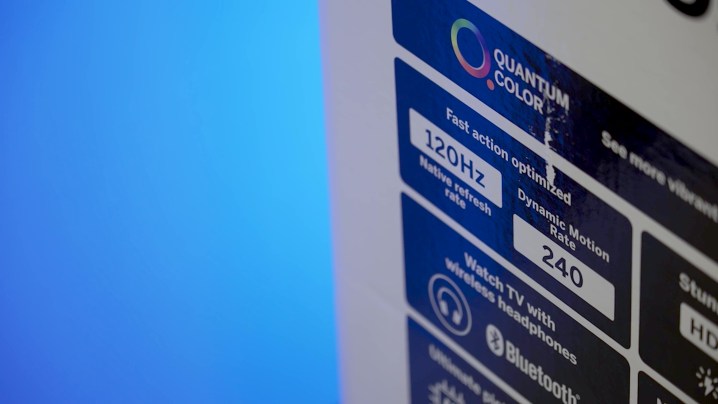
Now, if we keep using the Hisense U6H as an example, it does sports well thanks to good pixel response time and good processing. Two out of the three, right? Even though it doesn’t have a 120Hz panel, it does a solid job with the 60Hz panel that it has thanks to decent processing.
This brings me to my next point: You don’t have to get a TV with a 120Hz refresh rate — which is a very common recommendation, and one that I’m about to repeat — but it’s not a bad idea to have a 120Hz panel be a baseline requirement.
I’m making a big deal about the motion because it’s one of the biggest issues when watching sports.
I don’t want to get too deep into the tech weeds here, but the takeaway I want you to have is that 120Hz panels don’t go in cheap TVs. TVs with 120Hz panels need more expensive hardware to support them. In other words, that 120Hz spec is an indicator of quality, and it can provide some assurance that the TV it’s in is going to be a pretty good one.
Here’s the catch, though: It has to be a 120Hz native panel. And I mention that distinction because TV brands are out there trying to trick you. If you see 120Hz Clear Motion Rate, or 240 Hz Motion Flow, or some other such nonsense — that’s the TV maker trying to pull a fast one. Look at a spec sheet and make sure it says 120Hz panel because the better panel is the indicator that it’s a better TV. Yes, it’s worth the hassle of taking a look at a spec sheet. If you go up to the salesperson on the floor and ask them if the TV you’re looking at has a 120Hz native panel, and they look over at the box to check? That means they don’t know and are relying on the same marketing speak on the side of the box that you would be. So, get on the internet and check. It’s worth the 30 seconds or so it’ll take.
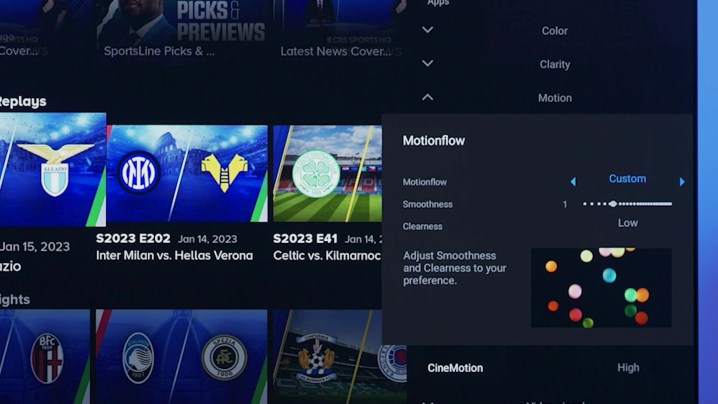
Now, the last thing I want to say about motion — and I’m making a big deal about the motion because it’s one of the biggest issues when watching sports — is in regards to motion smoothing, aka the “soap opera effect.” That’s frame interpolation — the stuff marketers call Motion Flow, or Smooth Motion or whatever. If you’re OK with that, then that’s fine. You can use it, and you won’t get a blurry picture.
Be aware that some people claim it makes things look fake or two-dimensional — it’s the kind of thing that’s almost always enabled on the TV in your hotel room, and it has sort of a soap opera look to it. If you’re good with that, then almost any decent TV with it turned on is going to be able to make fast-looking sports look clear. But if you hate that look and don’t want it, get a TV with a 120Hz panel to be safe.
Bright and beautiful
OK, enough about motion, what else should you be looking for? Let’s talk visibility. You want the picture to be bright and clear. Most TVs on the market today get plenty bright enough. The thing you should be aware of is how reflective the screen might be. If you have a lot of light coming into the room from windows or if you have a light source behind you when watching TV, there’s a good chance that if your TV is too reflective, that bright light is going to wash out your picture and become a distraction. Again, this is only a concern for certain viewing situations, but I mention it because it is basically the only factor that could make an OLED TV not be the best option.
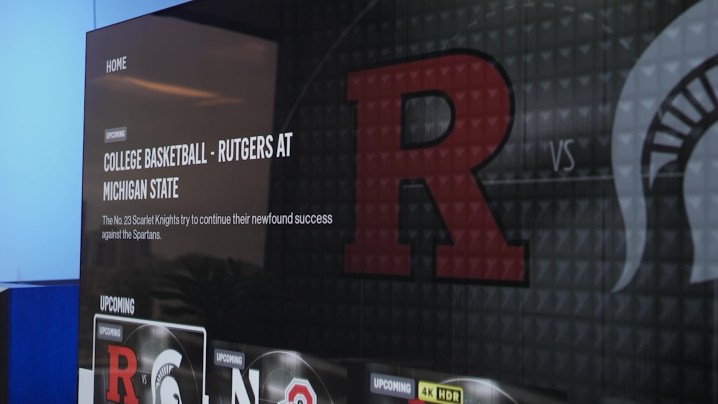
And let’s just address that right now. The best TV for watching sports in almost all cases is an OLED TV. They have instant pixel response time, they all have 120Hz panels, and they are all quality TVs, so the motion processing and upscaling are about the best you can get from any TV. OLEDs rule for sports. That is unless super-bright light is coming into your room from an angle that would cause the glossy screen on that OLED TV to act like a mirror. Otherwise, OLED all day, every day.
For the rest of you looking at LED/LCD or QLED TVs – there are a couple more things to be aware of on the TV side of things, and then I want to talk about how you go about watching the game and how it can make a difference.
How to avoid dirty screen effect
The next thing to check for is screen uniformity. What you don’t want is a splotchy screen. And, unfortunately, you aren’t going to know whether you’ve got a splotchy screen until you get the TV home. Yes, sometimes getting the best TV for you can be a hassle, and I’m sorry that’s the case. But get the TV home, plug it in — you don’t want to get it all set up or wall-mounted yet — connect it to the internet so you can stream YouTube, and then stream a screen uniformity test clip.
If you see really bad splotchiness? I mean, if it just looks like someone spilled grease all over your brand-new white or gray T-shirt? Then that TV has major screen uniformity problems and you WILL see those splotches when watching football, golf, hockey, or anything else with big wide areas of consistent color. If you want to know more about dirty screen effect, you can check out my article about it.
The best color
And, finally: color. It’s easy to see bad color on a TV when watching sports. Now, fortunately, the fix for bad color on a TV is usually just a matter of not using the Vivid or Sports mode. I know it sounds stupid since I know that you want your TV to look vivid and you’re watching sports — why wouldn’t you use those picture modes?
The answer is that they are hot trash when it comes to color. They sacrifice just about everything about picture quality to make sure the picture is bright as can be — and honestly, a big reason brands do this is that they need to stand out among a crowd of TVs with a bunch of fluorescent lights beaming down from the ceiling.
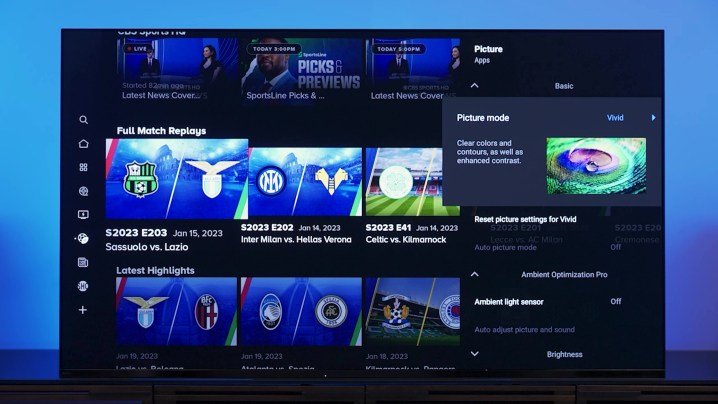
Pick the Standard picture mode if you must, or use something like ISF Bright, or the Cinema or Movie preset, and then pump up the backlight. This will get you a brighter picture while maintaining color accuracy, and I think you’ll be happier in the long run.
So that’s the cheat sheet for finding a good TV for sports. A 120Hz panel is a great start, and make sure it has a decent antiglare or antireflective coating on the screen if you watch in bright environments. When you get it home, check for dirty screen effect and exchange it if you happen to get a bad one — which really doesn’t happen all that often — and then when you do get it set up, avoid the Vivid or Sports picture modes.
How to watch
Now what about how you watch the game? Are streaming apps better than cable? What about an antenna?
In my experience, one of the most common ways to watch sports is also one of the worst in terms of picture quality: That would be cable or satellite. Now, if the only way for you to watch is cable or satellite, then watch that way. But if you are able to live stream the game or match over the internet, you might want to go with that option for a few different reasons. Also, if the game is going to be on a big network like ABC, NBC, CBS, or Fox, then you might want to try picking up one of your local broadcast stations with an antenna. The reason either one of those options will probably look better than cable or satellite comes down to a few factors.
The biggest one is compression. Cable and satellite operators have to cram a ton of signal down a pretty small pipe. Even if you have fiber-based cable with loads of bandwidth, cable operators are usually still sending the same bundled signal down that pipe, too. It’s highly compressed so it fits, and lower bit rate and bit depth mean less pixel information and less color information. Don’t get me wrong, cable/satellite can look very good. But streaming, if you have a solid connection and good bandwidth, can look even better.
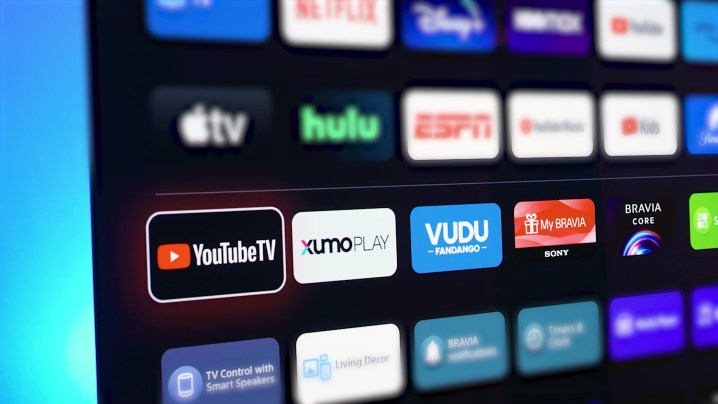
Now, for streaming, if you’re going to use a live TV streaming app, my experience has been YouTube TV has been reliably solid for picture quality. But the better play would be to use the network’s own streaming app — like the Fox Sports app, for example. In fact, sometimes you’ll get an HDR signal that way. But don’t expect 4K — and if you do get 4K, just know that it’s upscaled 1080p at best. Which, honestly, is better than the 720p or 1080i signal that you’d normally get.
Using an antenna, as old school as it may sound, can also be a good move to get better picture quality. It’s also less compressed than cable — and it’s free! Plus, if you happen to live in a market where ATSC 3.0 broadcasts are live, it might even look just that much better. That hasn’t been my experience here in Portland, Oregon, but your market might be different.
So there you go! That’s my advice on what’s really important if watching sports is your first priority. And the bonus is that a TV that’s great for sports tends to be great for just about anything else you like to watch.
Editors' Recommendations
- Best Buy TV deals: Save on QLED TVs, OLED TVs, and 8K TVs
- Sony debuts the Bravia 9, its brightest 4K TV ever, alongside new 2024 models
- Best LG C3 deals: Get up to $1,000 off the popular OLED TV
- How to watch Super Bowl 2022 on a Samsung Smart TV
- How to recycle your TV



